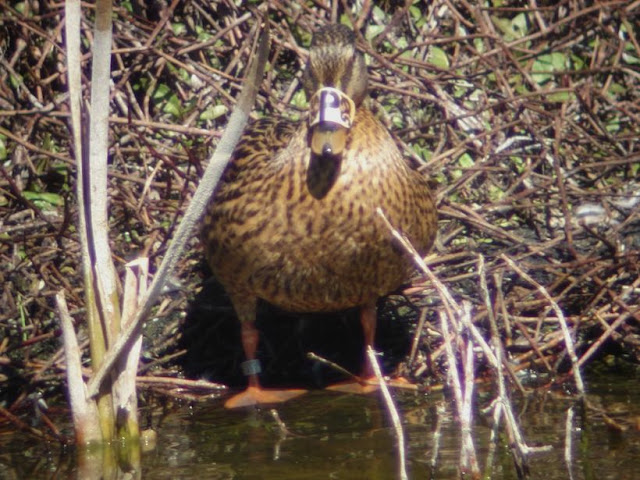 |
|
Ring M037213,
as it was found at the Eirol landfill on February 5, 2013
|
This particular metal ring (Lisboa M037213) was found on the bare sand of a yet unused part of the bottom of the landfill site. It was still attached to a (relatively short) tarsus and foot, of which the color of the flesh appeared to be orange. The ring itself was about the same size as used on the larger gull species. The whole set (leg and ring) had obviously been regurgitated by a gull at the spot, as it was lying among numerous other food remains at this gull roost.
 |
|
The yet largely unused open dump
site of the Eirol landfill, containing a large short term gull roost.
|
It did not take much effort to find out where and by whom this bird was ringed; the first birds with orange legs that came to my mind were ducks, so Portugal’s duck expert David Rodrigues (http://www.pt-ducks.com/) would be the right person to turn to. I help David on a regular basis with trapping, marking and monitoring ducks at the ponds of the Sao Jacinto reserve. As part of this ongoing project, captured duck are applied with a metal (Lisboa) ring and a unique nasal marker, allowing individual recognition of the released birds in the field, to study movements and migration, survival rates and fidelity rates to wintering grounds, as well as other aspects of duck bio-ecology.
In Portugal the annual survival of ducks is negatively influenced by widespread hunting activities. The idea is/was that when a hunter shoots a marked duck, he (or she??) will report the ring or saddle code, by which way insight is gained in the impacts of hunting on the duck populations. In the past some local hunting associations and their members have been informed about the existence of this project.
 |
|
A marked and
studied female Mallard, wearing the usual outfit of one nasal saddle (in this
case S0/P/S0) and one unique metal ring.
|
David recently informed me that M037213 had been applied on an adult female Mallard Anas platyrhynchos that was captured at the duck pond of Sao Jacinto on August 3, 2011. This bird was also given a nasal saddle with the code M0/Y/M0. It weighed 885 grams, had a wing length of 156 mm and was moulting primaries in the duck pond of Sao Jacinto. After its release that same day it was never resighted, neither recaptured.
When M037213 got prepared for the kitchen, most of its leg got cut off, as the tibia appeared to have been cut through just above its connection with the tarsus (probably with a knife). M037213’s leg and ring were thrown in a bin and ended up on the landfill, where they got swallowed by a gull, regurgitated in the pit, and eventually found there and reported by me.
I don’t believe not reporting a ring is considered a crime; it is certainly lame from my perspective. From a hunter’s perspective it may be acceptable to dispose the evidence that another duck had been shot. But for the least metals should be recycled. They should not end up in compost, but can be disposed in separate bins. Or maybe an example can be taken from Africa, where bird rings sometimes get reused for a necklace. Of course, the hunter still has the possibility of reporting the ring, but my confidence in the combination of hunting and science continues to decrease by the day.

No comments:
Post a Comment